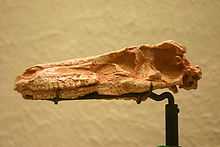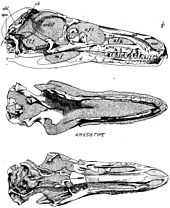Saurornithoides
| Saurornithoides Temporal range: Late Cretaceous, 75Ma | |
|---|---|
 | |
| Holotype skull, AMNH 6516 | |
| Scientific classification | |
| Kingdom: | Animalia |
| Phylum: | Chordata |
| Clade: | Dinosauria |
| Clade: | Theropoda |
| Superfamily: | †Troodontoidea |
| Family: | †Troodontidae |
| Genus: | †Saurornithoides Osborn, 1924 |
| Species: | † S. mongoliensis |
| Binomial name | |
| Saurornithoides mongoliensis Osborn, 1924 | |
Saurornithoides (/sɔːˌrɔrnɨˈθɔɪdiːz/ saw-ROR-ni-THOY-deez) is a genus of troodontid maniraptoran dinosaur, living during the Late Cretaceous period. These creatures were predators, which could run fast on their hind legs and had excellent sight and hearing. The name is derived from the Greek stems sauros (lizard), ornithos (bird) and oid (form), an appropriate name for a creature close to the ancestry of birds.


Saurornithoides, like others in its family, was probably predominantly carnivorous. Estimates of its length range from 2 to 3 metres (6.6 to 9.8 ft) and weight from 23 to 54 kilograms (51 to 119 lb). It had large eye sockets and stereoscopic vision, allowing for good depth perception. It probably had good vision in light and very good night vision. It had a long, low head, a depressed muzzle, sharp teeth and a relatively large brain. Swift and smart, like its North American cousin Troodon, Saurornithoides probably scoured the Gobi Desert, looking for small mammals or reptiles to eat. Scientists speculate that it used its long arms and grasping hands to seize live prey, which would have consisted of small animals. Like other troodontids, it had an especially large claw on the second toe of each foot.
A single specimen of this theropod has been found in the Djadochta Formation of Mongolia. Saurornithoides was named by paleontologist Osborn in 1924. The type and only species is S. mongoliensis.[1] A second species, S. junior, was named by Rinchen Barsbold in 1974, based on a larger specimen from the Nemegt Formation thought to be more closely related to S. mongoliensis than to other troodonts. However, a 2009 review of the genus found that the support for this idea was lacking, and re-classified S. junior in the new genus Zanabazar.[2]
References
- ↑ Osborn, H.F. (1924). "Three New Theropoda, Protoceratops Zone, Central Mongolia." American Museum Novitates, November 7, 1924 (144): 12pp.
- ↑ Norell, Mark A.; Makovicky, Peter J.; Bever, Gabe S.; Balanoff, Amy M.; Clark, James M.; Barsbold, Rinchen and Rowe, Timothy (2009). "A Review of the Mongolian Cretaceous Dinosaur Saurornithoides (Troodontidae: Theropoda)". American Museum Novitates 3654: 63.
- Fantastic Facts About Dinosaurs (ISBN 0-7525-3166-2)
- Lessem, Don Dinosaurs A to Z. Page 170, 2003. (ISBN 0-439-16591-1).